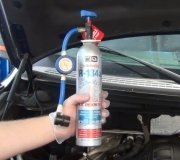Hi guys. I suspect you grossly over-charged the system. There is no such thing here as "some is good so more must be better". The amount specified results in there being just enough that the evaporator in the dash is half-filled with liquid and half with vapor. That is the point where the liquid turns to a vapor, and that is where it gets real cold. If there is too little refrigerant in the system, it turns to a vapor in the hose under the hood leading to the evaporator. If there is too much, it turns to a vapor in the hose going out to the compressor. It does not do any good to become cold under the hood.
The two cans you put in at first were almost a full charge. If there was some refrigerant in the system when you started, it may have been over-charged then. Adding two more cans would end up for sure with one and a half cans too much. Even worse than becoming cold under the hood, that liquid can slosh into the compressor and destroy it. Compressors can only compress a vapor, never a liquid.
If there is a leak bad enough to leak out most of the refrigerant in a few months, I too would be worried about the lack of oil Steve W. Is concerned about. You should see that oil around the point of the leak.
With the engine off, I would try to spin the compressor by hand to see how it feels. The outer plate should turn freely with no binding or roughness. If it does, consider having the refrigerant recovered by your mechanic. Most machines measure the amount removed, then have them pump in the correct amount. That is the only way to know exactly how much is in the system. Only older Chrysler products had a sight glass to let you see when the system was fully-charged. For all others, even the professional gauge set does not tell the whole story.
You did not describe the history, including how long the system wasn't working. If the refrigerant leaked out completely a long time ago, and was totally empty, it needs to be pumped into a vacuum for at least a half hour. That makes water boil at 77 degrees so it can be pulled out as a vapor. When air gets into the system, the humidity in it causes two problems. First, when you add refrigerant, it combines with the water to form an acid that attacks metal parts. That can lead to leaking condensers and evaporators. Second, if a droplet of water circulates through the system, it will freeze and block the valve that regulates flow into the evaporator. That stops the cooling for up to an hour until that ice melts and starts to circulate again.
Saturday, September 2nd, 2017 AT 5:28 AM


